- January 26, 2019
- Posted by: master
- Category: advance
Wearing her hijab, “Mounia” from Yemen heard the gospel and felt the love of God in our international church because of her Rwandan classmate’s invitation and her husband’s permission. Without Arabic or visa for Yemen, instead of flying to Sana’a, we walked two meters to welcome her. From a country with 0.03% evangelicals, could she take the gospel back home?
“Lazaro” from Tanzania said with resolve, “While in China, I want to fill my life with the Word of God.” He’s an active member of our fellowship, here with his wife and two little daughters, struggling with racism towards Africans, yet hungry to grow and return home equipped as a disciple of Christ. Could he strengthen the church in Tanzania?
These are some of the almost half a million international students in China, arriving from every corner of the globe into a context where cultural complexity meets contextual limitations and gospel opportunities. They form a mixed, dynamic and growing field of ambitious influencers of the next generation. Among them are the prime ministers, CEO’s, policy-makers and leaders of the future.
How can the global church embrace this opportunity?
GROWTH IN INTERNATIONAL STUDENT POPULATION
Who knew that China is the third largest destination for international students worldwide, after the USA and the UK? With 442,733 international students in China during 2016, up 11.4% from 2015, this number has multiplied over the past ten years. It seems that, with consistent growth, high numbers, and such diversity, China is becoming the “hub of hubs” for impacting the world through international students.
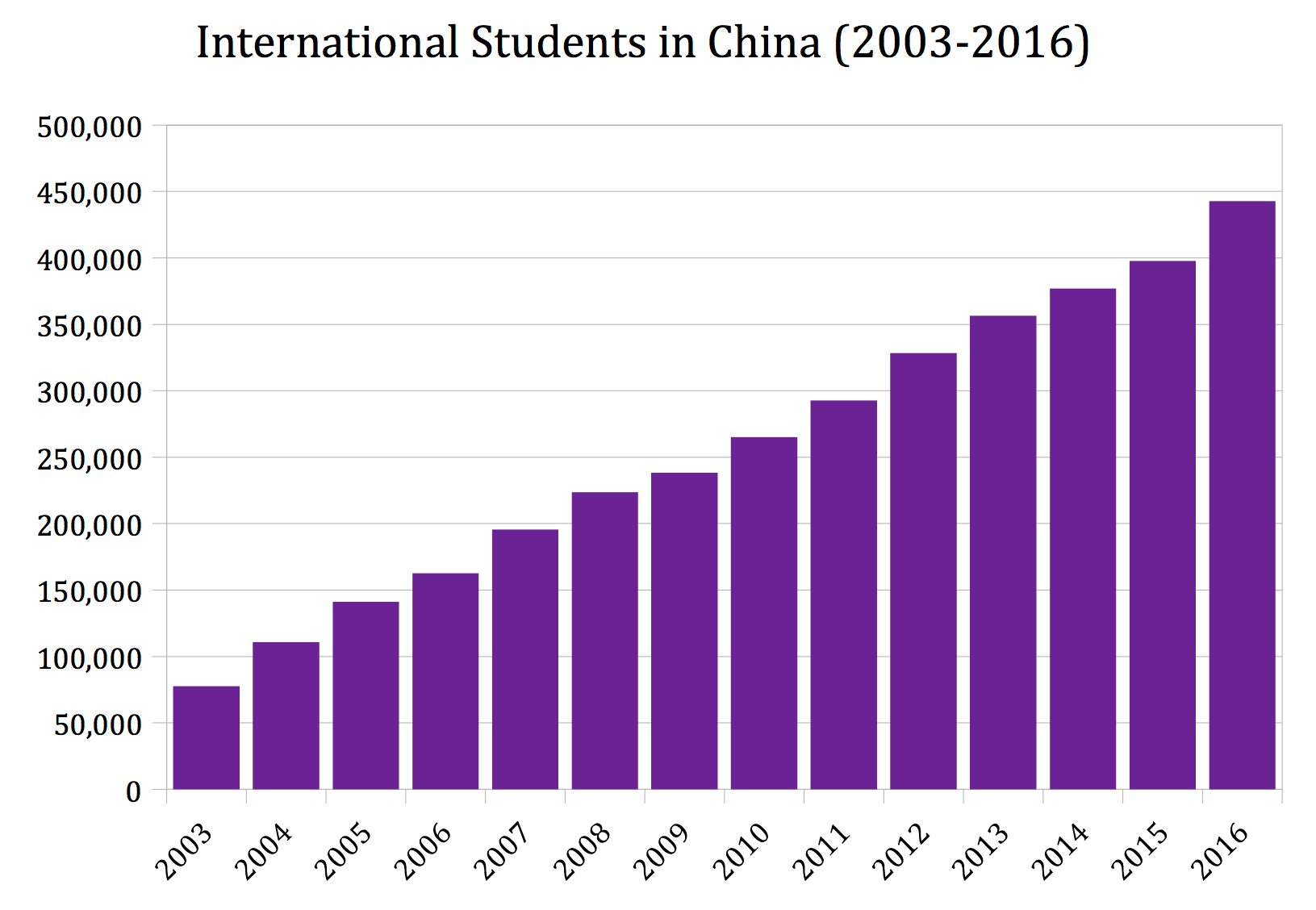 SENDING COUNTRIES
SENDING COUNTRIES
Students come from virtually everywhere. This map from 2016 shows that international students at Tsinghua University were from 116 nationalities.
Across China, almost 60% of international students come from Asia (including Central Asia and the Middle East). One explanation may be the growing phenomenon of “glocal” students—those who pursue a foreign education while remaining in their country or region. It is cheaper and culturally more comfortable than going to the West.
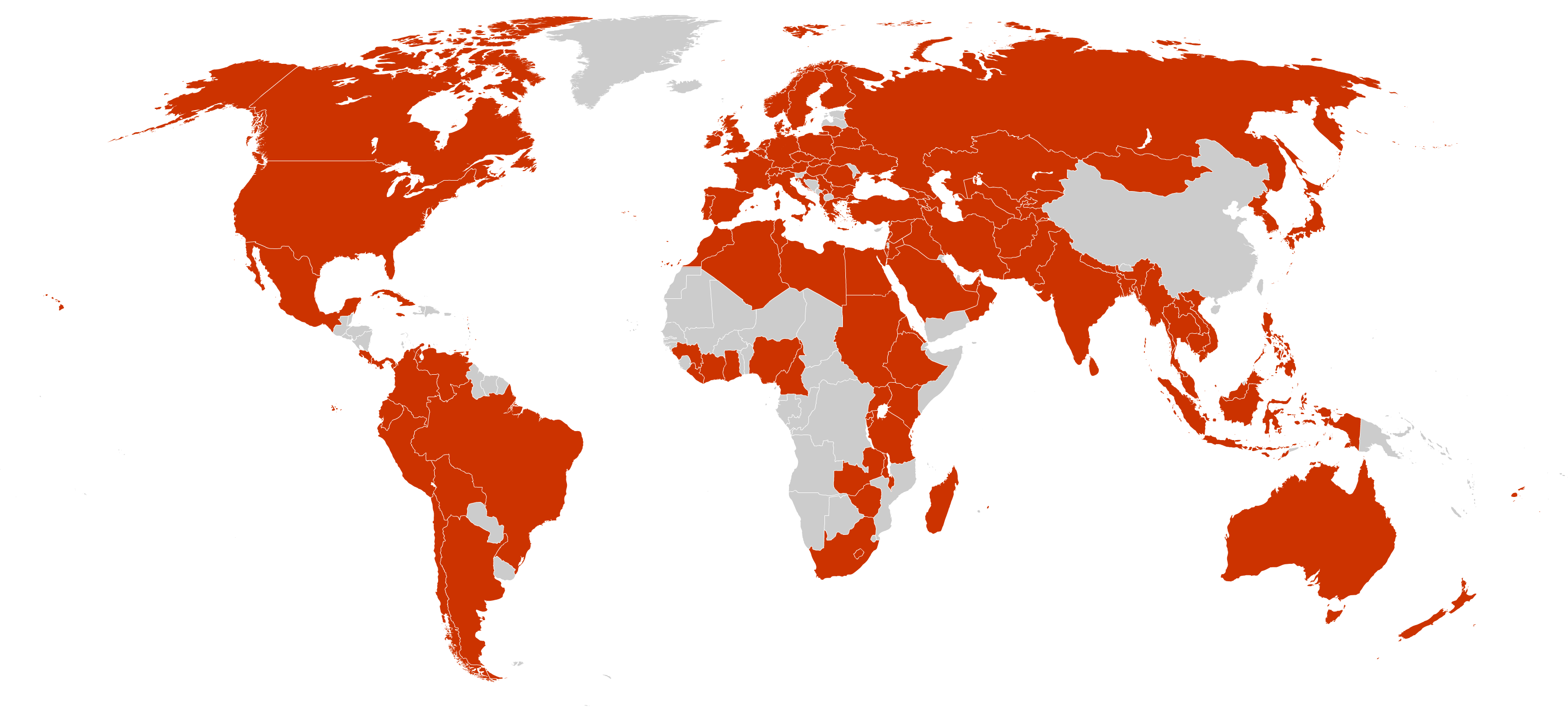
Across China, almost 60% of international students come from Asia (including Central Asia and the Middle East). One explanation may be the growing phenomenon of “glocal” students—those who pursue a foreign education while remaining in their country or region. It is cheaper and culturally more comfortable than going to the West.
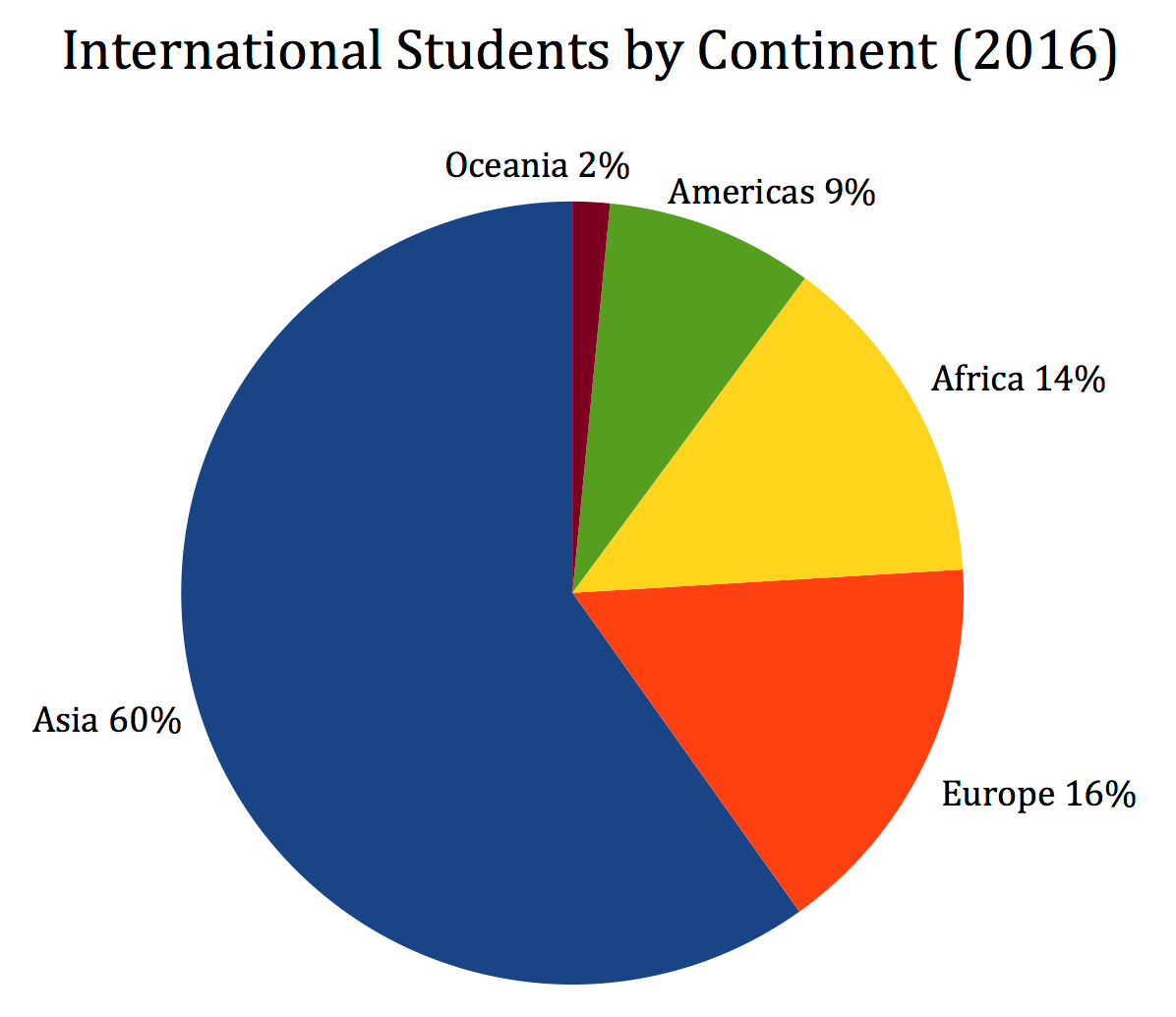
However, the staggering growth is from Africa, with a 23.7% year-on-year increase from 2015. Globally, China is the leading destination for Anglophone Africans. Though South Korea sends the most students from a single nation (15.93%), African students in total constitute the second largest group, with almost one in every seven being African. Scholarships from both China and sending countries drive this growth, as does China’s proactive and engaging geopolitical stance especially in strengthening bilateral economic relationships.
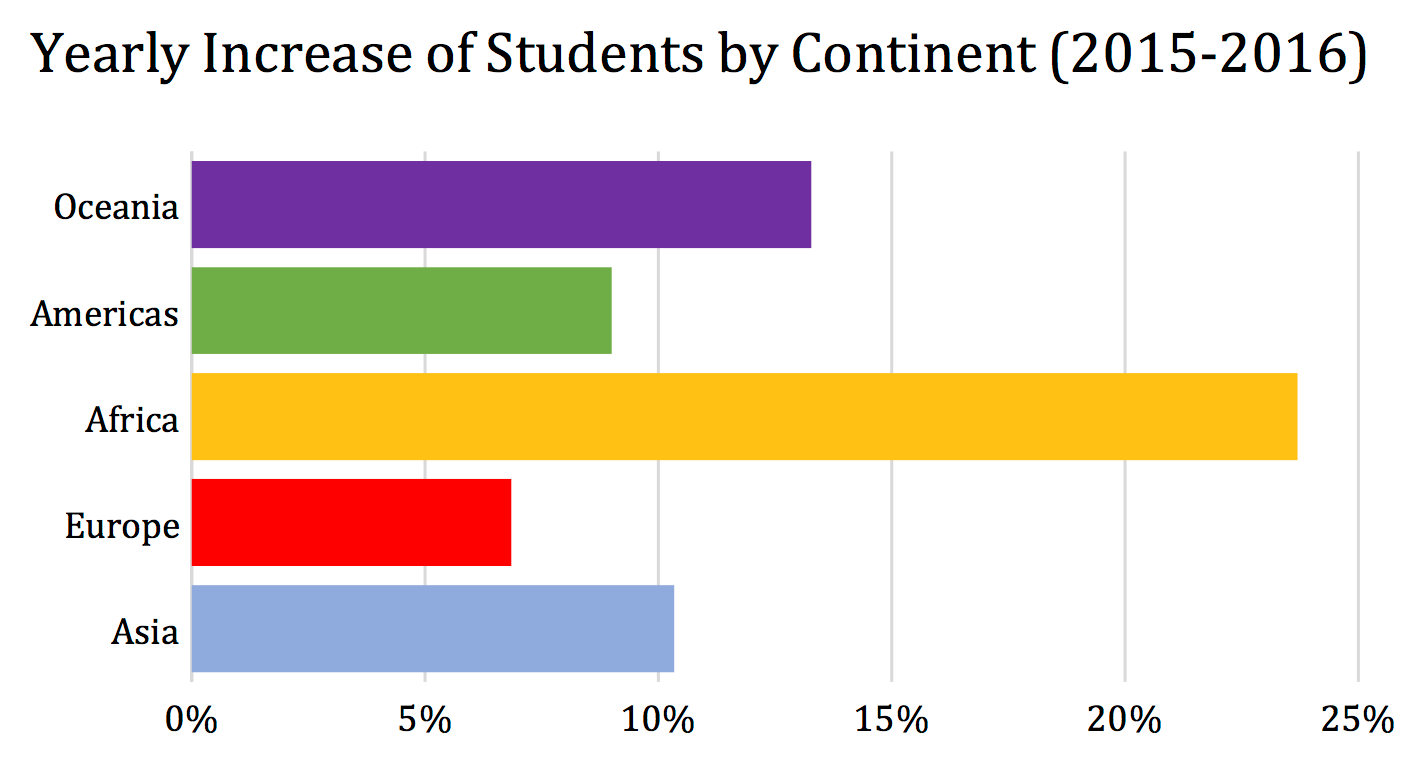
Most of the top 15 sending countries are Asian, and they are incredibly mixed. Eight of these—totaling almost 120,000 students—are classified as “unreached” or “minimally reached” with the gospel.
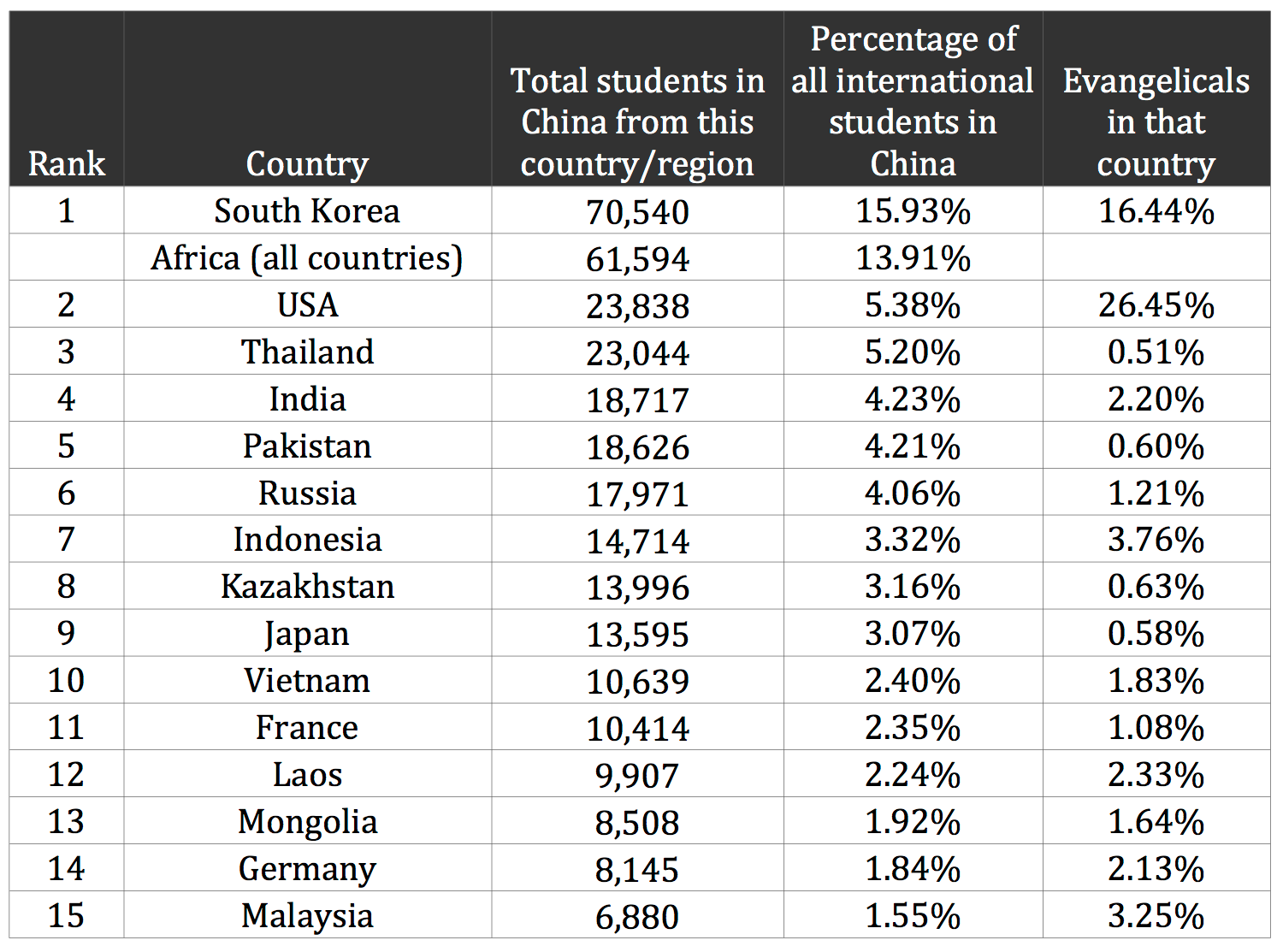
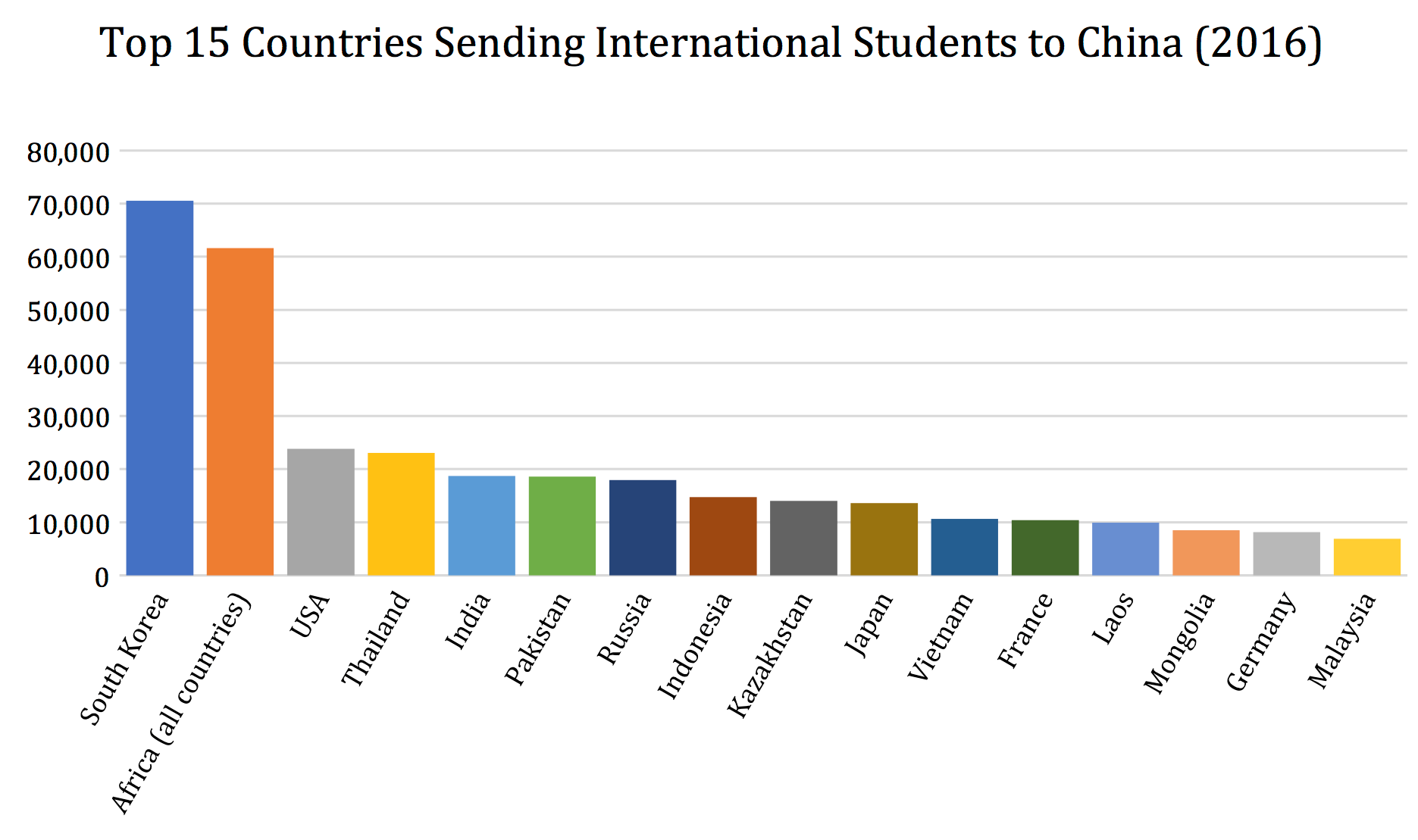
Yet, surprisingly, despite China’s reputation for control and constraint, these students can freely visit an international fellowship or engage with believing classmates. The young adult worldview exploration and reassessment engenders great openness. Is this an opportunity to reach the unreached?
DESTINATIONS IN CHINA
Though Beijing (17%) and Shanghai (14%) attracted the lion’s share of international students in 2016, there was a notable spread throughout the country.
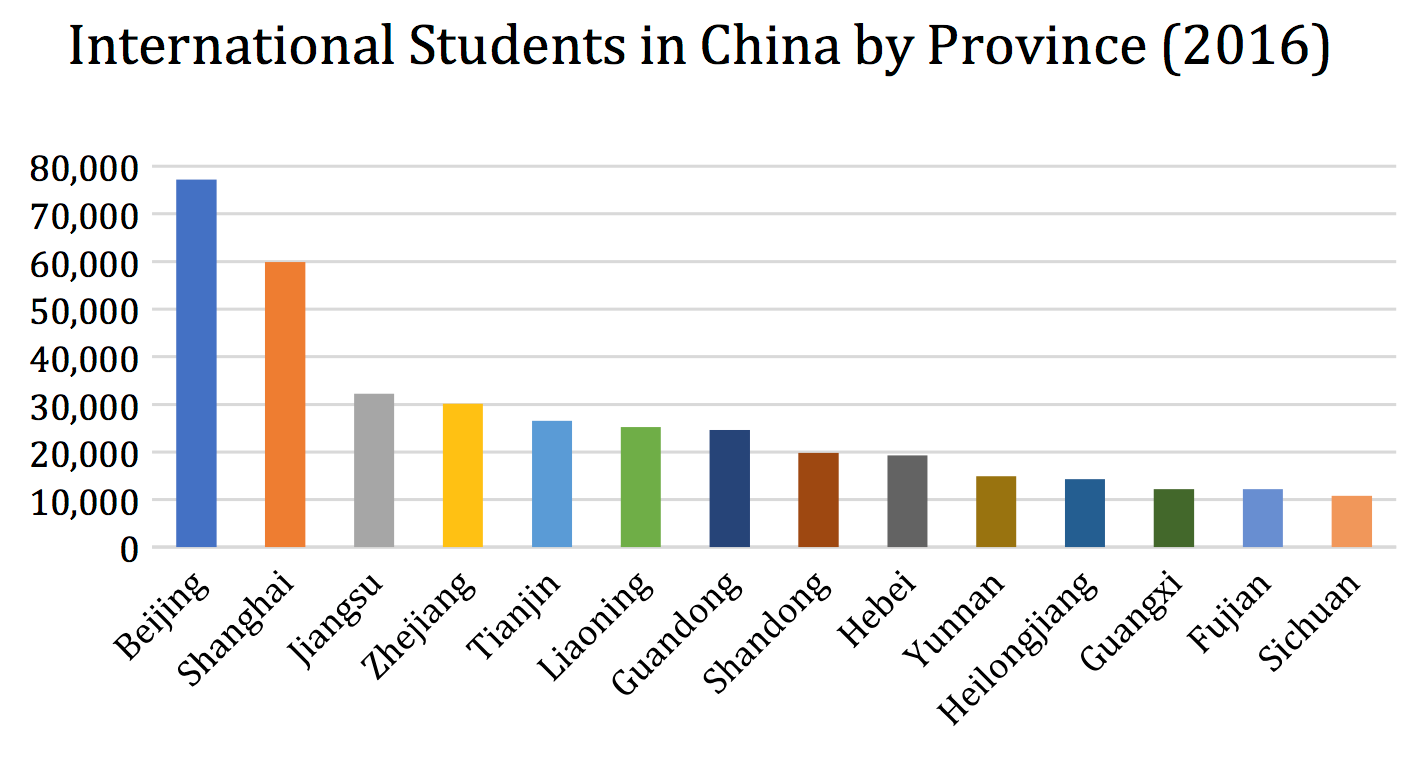
REASONS FOR COMING
Due to a combination of diverse factors, China will continue to grow as a destination for international students. It has some of the world’s top universities, boasts a great diversity of institutions and programs, and is much cheaper than western destinations. Well over 800 colleges and universities in China accept international students, with many offering accessible undergraduate and postgraduate courses entirely in English.
Moreover, Chinese universities are gaining a reputation as attractive research environments. An outward-facing international education strategy for 2020 combined with massive investment (49,022 scholarships in 2016) has attracted many students. In China, international students account for only 0.9% of total higher education students, compared to over 20% in the UK and Australia, leaving significant capacity to welcome more foreign students.
STUDENT DIVERSITY
Compared to many western contexts, the international student population in China seems more culturally diverse, so there is more potential for intercultural conflict. What is acceptable to one student may offend another. In addition, cultural naiveté makes it hard for students from culturally homogeneous societies to comprehend, accept and befriend the other.
It is widely assumed that all international students in China speak English. They do not. In fact, many international students, like the growing number from Central Asia, do not have functional English. Furthermore, even those who speak English cannot always understand one another. So, sometimes the best way to communicate is with limited Mandarin—the new lingua franca. Linguistic diversity means that ministry is not just in English. When an American Christian international student recently gathered over a dozen classmates and friends together for a Christmas party—from the USA, South Korea, Thailand, Japan, UK, Australia, Mongolia, Uruguay, Russia, and China—the conversation was entirely in Mandarin. Though the most effective ministry is of course in someone’s heart language, anyone—foreign or local—who can speak Mandarin can easily connect with vast numbers of non-English-speaking international students.
Religious diversity means international students include Muslims, Christians, Buddhists, Hindus, atheists, agnostics, and Baha’i. Amongst those identifying as Christians, one finds all affiliations and levels of commitment. Various cults also have an established presence, attracting lonely and stressed students.
All this precludes a “one size fits all” ministry model and demands creativity. Despite the challenges, international student ministry offers wonderful opportunities for gospel proclamation. With the control of family and home culture replaced with intriguing new freedom, students are asking, “What do I believe and why?”
LEADERSHIP AND MINISTRY POTENTIAL
Furthermore, a surprising number of Christian students come to China with church leadership experience. While some are confused or lukewarm in faith, others are eager to be equipped for ministry and are incredibly responsive to capable, intentional and loving ministry training. A Pakistani Christian student wrote, “Just need more prayers so I could work more for Christ and become a source of light for others.” Is this an opportunity to strengthen churches and train people for ministry?
Simply by being an international student and navigating all of the challenges listed above (unless they collapse under the strain), students become culturally adaptive and resilient. Is this an opportunity to train international students for cross-cultural mission beyond the diaspora in another culture?
Many international students will become influencers of culture and society in their home countries, as some already are. China’s scholarship policy attracts a higher proportion of graduate and postgraduate students compared to the West. Is this an opportunity to influence students’ home cultures with the gospel of Jesus Christ?
PRESSURES AND ISOLATION
However, there remain significant China-specific challenges facing students. The long-term homogeneity of Chinese culture heightens the culture stress of international students. Anyone who is not Chinese-looking is a 外国人, an “outside person,” and cultural integration proves difficult. Conversely, Asian students without the often-presumed language and culture smarts can face ridicule and stress.
Africans feel alienated, fearful, and powerless in the face of racism towards them. A Kenyan student sadly reported that often on a crowded bus both her adjacent seats would be empty—as people avoid sitting next to a dark-skinned person. Depression is widespread and suicidal tendencies not uncommon, but mental health and medical services are either rarely available or prohibitively expensive.
Dormitories rarely have spaces to congregate and socialize, while students’ financial, academic and time pressures work against forming deep friendships. The most popular messaging apps that students use—Facebook Messenger and WhatsApp—are blocked in China, choking the connection back home. Restricted freedom of association and university rules against proselytizing can leave students confused and fearful.
All these challenges contribute to isolation and loneliness which can weaken Christian international students, who may then drift towards unhelpful influences. Some students are entirely unaware that healthy international churches exist, or that a Bible study might meet on their campus. In the midst of these challenges, there is an opportunity to show the compelling love of Christ and embrace students in loving community.
International student ministry in China inevitably means it is pioneering. Yes, the challenges are immense, but so are the opportunities. Who will commit themselves to reaching, maturing and equipping these students to be salt and light throughout the world?
LESSONS FROM HISTORY
The conviction that God calls people from every nation, and that the nations had come to them, motivated the pioneers of international student ministry (ISM). Why and how did ISM movements start?
John R. Mott was moved to care for and evangelize foreign students in the USA. In 1911 he founded the Committee on Friendly Relations Among Foreign Students. As an international student in China in 1948, Bob Finley noticed the political impact of Chinese students returning from Russia. The strategic opportunities drove him to establish International Students Inc. on home soil “to evangelize, train and deploy foreign students back to their home countries for ministry.” And in 1954 Mark Hanna and John Bjorkland launched American Citizens Residing Overseas for Study and Service (ACROSS) “to empower Americans to study overseas and thereby evangelize in close[d] countries.”
DIASPORA MISSIOLOGY
In the last fifteen years, there has been significant development in diaspora missiology, which offers a biblical rationale and strategy for ISM, and gives us a framework for missions to, through, and beyond the diaspora. Leiton Chinn writes compellingly about the biblical basis and strategic value of ISM as part of diaspora missions. Elsewhere he describes his own journey and that of some churches in the USA from not seeing or caring about international students to now noticing and actively reaching out to them. With the same zeal, he points to ISM in Asia as “a most strategic yet least expensive global mission opportunity.” Is this a journey on which the church in China has now embarked?
Although there is a mind-boggling diversity of cultures and languages amongst international students in China, in many ways they can be considered together as a diaspora—a group of people maintaining strong connections with their home culture but living temporarily in another. However, this is a heterogenous diaspora gathered from almost every country and region of the globe.
From a kingdom perspective, the theological necessity and strategic value of ISM have been well established. But compared to the West, very few churches, organizations or individuals are dedicated to serving international students in China. If ISM in China is commanded by God, has encouraging historical precedents and makes sense strategically, who will reach them?
CHURCH IN CHINA
Christians in every place have a joyful responsibility to reach everyone in that place. So, is ISM a gift to the church in China? “Church in China” here means any local expression of the church inside China, including the national TSPM church, house or family churches (including returnee-based churches), international churches and campus ministries. ISM is inexpensive yet high-impact; it provides global connection locally and allows every member to be involved through using their gifts. Those unable to serve abroad can still engage in international missions at home, while others can prepare for working, serving and studying abroad.
Notwithstanding existing pressures, it could be argued that the Chinese church bears the primary responsibility to welcome these temporary neighbors with the gospel.
China’s international engagement is growing economically and politically. Perhaps Chinese believers could follow this trend and get more involved with internationals within their borders. Some Chinese brothers and sisters conclude they have no facilities or legal context for ISM, or that they lack experience and don’t know where to start. Others believe ISM is only for well-educated church members, and probably requires significant funds and highly organized teams. Many equate cross-cultural ministry with going outside of China or at least to remote domestic minorities. It takes courage to pray for, listen to, respect and discern the needs of international students in the megacities of China.
Some international students attend national TSPM churches which occasionally hold English services, but broader contextual constraints may make it difficult for these churches to reach international students effectively. Though notionally receptive to welcoming internationals, these churches appear to be doing very little in this area.
Vast numbers of Chinese have been converted while studying abroad. The challenges of reintegration into society and connecting with a local church are immense, so some churches have emerged which are mostly composed of returnees. Could the culturally and linguistically adept Christian returnees embrace this ministry opportunity?
A handful of house churches, both open and more discreet, are recognizing the joyful duty of sharing the gospel with international students living in China. While at times feeling ill-equipped, culturally uncertain and under-resourced, they have an excitement about reaching out. Some fellowships have quite a few academics and professors at universities where international student are located. Churches have set up “Chinese corners” (akin to English corners or conversation classes in the West) through which they hope to build friendships with international students who are looking for community and the opportunity to improve their Mandarin. However, some are unclear where the international students actually live, don’t know how to connect with them, and are fearful about inviting in the foreigner.
Encouragingly, despite language and cultural barriers and other hindering factors, some churches have been prioritizing reaching international students. One leader recently said that if the local church doesn’t preach the gospel to the nations, especially when they’ve come to China, then “we are sinning against God.”
Some local campus-based college ministries are also beginning to put international students on their radar. The idea of cultural exchange centers is growing as both a legitimate and strategic context in which to build friendships with international students. Undoubtedly there are lessons from the successful indigenization of college ministry in China which could inform a “sideways” development into ISM.
Although international churches in China are minor players within the “Church in China” category, healthy ones do operate in many major cities and have relative freedom to meet openly. Some have non-English congregations. Unfortunately, some Christian students arrive with the preconception that there is no church in China, so they hide and read their Bible secretly in their dorm room. For others, the neon lights of new liberties distract them from seeking out fellowship.
And though these international churches certainly welcome any international student who attends, there remain significant political and capacity limitations. And there are challenges of doing church in a non-first language, a church culture that’s radically different from “back home,” and an environment with strong ethnic cliques and cultural misunderstandings.
But students who do integrate into these fellowships often encounter great encouragement from meeting with those who are culturally similar and others who can sympathize with them. And to many, it is also a surprising and glorious thing to witness the unity with diversity of the nations worshipping together, as described in Revelation 7.
CHURCH OUTSIDE OF CHINA
Finally, how can the global church outside of China be part of this ISM vision in China? First and foremost, brothers and sisters could commit to praying for this.
Experienced ISM workers could be sent to China to support international churches or to come alongside local Chinese fellowships and campus ministries. Networking could be established between healthy national ISMs, pioneering ISMs outside of China, international churches within China, global sending organizations, and the nascent Chinese ISM movement.
The idea of sending people to a place to minister to those who are not of that place can be a challenge. Some sending organizations have historically focused only on strengthening the Chinese church. Quite apart from recognizing the reality of diaspora mission “from everywhere to everywhere,” could embracing ISM be a strategic way for them to grow the Chinese church’s cross-cultural vision and capacity to fulfill the Great Commission? The reality of diasporas raises healthy questions about the best shape and mode of sending agencies.
Today programs exist to facilitate mission-minded students to go abroad for study in China. Up until now, they have focused on reaching Chinese, not international students, but gradually they are embracing the strategic value of ISM-focused study-abroad students. For example, the Nigerian church is considering sending graduate students who are eager to reach internationals. Since the Christian center has shifted to Africa, Asia, and Latin America, there may be a responsibility for those regions to send ISM workers and mission-minded students to China.
THE ROAD AHEAD
Let the global church together with the people of God in China pray for international students in China. We must repent for lack of vision and action, and now joyfully take up this opportunity.
There may be much gospel fruit from listening to Chinese Christians’ hopes, fears, and needs in the area of reaching international students. Together we need to understand the context better, identify those on whom the Lord has placed a burden for international students, discern opportunities, and develop practical ministry models.
Perhaps God is giving us the compassion Jesus had, placing international students squarely on the agenda of both the local church in China and the global church beyond.
“Ask the Lord of the harvest, therefore, to send out workers into his harvest field” (Matthew 9:38). International students in China are this field, ripe for harvest. Who will love them?
* This Article was published on Evangelical Missions Quarterly (EMQ) by Missio Nexus and was given permission to re-publish on Asian Missions Advance.
===========================
Phil Jones
philjones2510@gmail.com
Phil Jones (pseudonym) and his wife have been working amongst international students for over twelve years, both in their home country and for three years in China. They are growing in their awareness of the opportunities to reach the nations who have come to China.
Leave a Reply
You must be logged in to post a comment.
